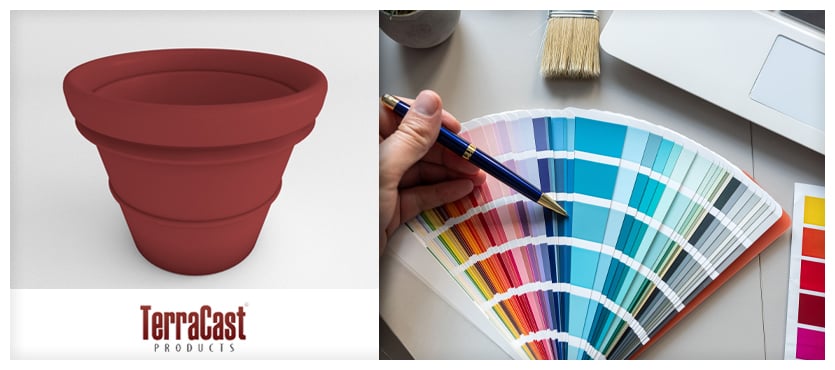In urban planning and public space design, the concept of safety goes far beyond physical barriers and security measures. While materials like resin offer vandal-resistance, durability, and graffiti protection, color selection can also play a surprisingly powerful role in shaping how people feel in a space. Color psychology—how humans perceive and respond to different hues—can influence everything from perceived safety to wayfinding and emotional comfort. When applied thoughtfully, it becomes a strategic design tool for cities, municipalities, and institutions seeking to create inviting, low-crime environments.
As communities increasingly prioritize wellness, inclusivity, and visual appeal in public infrastructure, TerraCast® Products offers solutions that merge durability with design flexibility. With a wide selection of custom resin colors, our planters, benches, and other furnishings are ideal tools for integrating color psychology into modern public spaces.
The Emotional Impact of Color in Public Environments
Colors communicate silently but powerfully. While cultural interpretations vary, many color associations are universal:
- Blue: Often associated with calm, reliability, and trust. Common in healthcare and transit settings to reduce stress.
- Green: Represents nature, renewal, and peace. Ideal for parks, courtyards, and relaxation zones.
- Yellow: Cheerful and energetic, but best used in moderation. Overuse can create visual fatigue.
- Red: Stimulating and attention-grabbing. Effective for alerting or designating high-traffic areas, but may feel aggressive in excess.
- Gray and Neutrals: Evoke modernity and minimalism, though overly gray spaces may feel cold or uninviting without accent colors.
- White: Clean and open, but easily soiled. Often used in combination with more grounded colors.
By understanding these associations, architects and planners can use color as a soft control mechanism—guiding how people move through space, feel in that space, and interact with others.
Color and Perceived Safety
When people enter a public plaza, transit hub, or downtown street, they make subconscious judgments within seconds. These assessments are based not only on cleanliness and lighting but also on color cues. Dull or deteriorating colors can create a sense of neglect, potentially encouraging loitering or criminal behavior. In contrast, well-maintained, vibrantly colored furnishings suggest care and oversight, which in turn reinforces positive behavior.
In this way, color psychology complements principles from CPTED (Crime Prevention Through Environmental Design). A lively planter with bright florals and bold color placement can subtly signal: This space is loved. Someone is watching. This area is safe to enjoy.
Wayfinding and Visual Organization
Colors also help users orient themselves. Urban planners can use coordinated planter colors to define zones—such as warm tones near seating areas and cool tones along walking paths. This is especially useful in large public campuses, municipal complexes, or transit areas, where visual consistency improves flow and navigation.
Contrasting colors can also create visual borders without physical barriers. For example, using dark-toned resin planters along the perimeter of a dining zone can signal a threshold without obstructing foot traffic. These subtle signals improve clarity while maintaining an open, welcoming environment.
Enhancing Community Identity
Color selection doesn’t just influence emotion—it tells a story. Many cities now brand their public furnishings using colors tied to local identity. Whether it’s aligning with school colors, sports teams, or cultural heritage, custom-colored planters and benches can become part of a city’s visual language.
TerraCast® supports these efforts with customizable resin options that allow municipalities and design firms to match their vision with precision. Our UV-resistant, maintenance-free finishes ensure that these colors remain vivid, even in harsh climates.
A Flexible and Durable Canvas
Unlike painted metal or concrete, TerraCast® resin furnishings feature integral color throughout the product. That means the color is embedded into the material, not just applied on the surface. Scratches, chips, and graffiti won’t expose a different underlayer—helping maintain a polished, uniform look over time.
This not only increases longevity but also reduces the need for repainting or touch-ups—an essential advantage for cities managing long-term maintenance budgets.
Color with Purpose
Color is more than decoration. It’s a communication tool, a mood-setter, and—when combined with resilient materials like resin—a way to create safer, more welcoming public spaces. TerraCast® planters, benches, and furnishings give designers the power to use color intentionally, whether to encourage calm, spark joy, or simply unify a space.
If you’re planning a new public design project, consider how color can support your safety goals. With TerraCast®’s custom color capabilities and durable resin construction, your vision can take shape in a way that’s both beautiful and built to last.
To learn more about our customizable planter colors and design solutions, get in touch with the TerraCast® team here.

